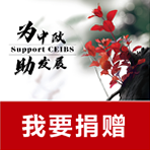Chocolate Diplomacy: An Austrian Firm’s China Story
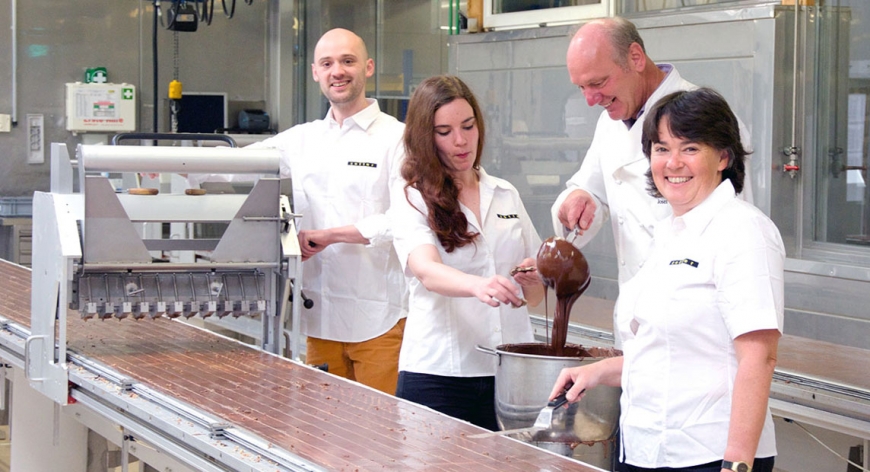
This is the story of how an Austrian family, with a strong Chinese partner, charmed their way into becoming part of the Shanghai landscape. It is an excellent example of successful China-EU collaboration; but this story does not focus on high-level diplomacy. It focuses, instead, on the power of chocolate – and what can be accomplished when individuals from different parts of the globe leverage each other’s strengths to achieve a shared goal. Read on for excerpts from the case Zotter Chocolate: Creating a Market in China, written by CEIBS Associate Professor of International Business and Strategy Shameen Prashantham and Researcher Dr. Liman Zhao. Then in the Q&A that follows, Professor Prashantham provides real life lessons from the case – for both European and Chinese players.
In December 2012, Zotter Organic Chocolate Shanghai Ltd. was formally registered. By the end of March 2014, Zotter’s brand-new Chocolate Theatre opened on the banks of the city’s Huangpu River and customers could buy about 365 different kinds of chocolates from Zotter China. Julia Zotter, the company’s representative in China, credits much of their success to their excellent Chinese partner, Amy Fang (CEIBS EMBA 2010). The company had come a long way from its origins as an Austrian candy shop being run a by a pastry chef and his wife.
Founding Zotter Chocolate
In 1987, Josef and his wife Ulrike Zotter opened the Zotter Konditorei confectioners in Graz, the second largest city in Austria. The company’s rapid growth meant it was not difficult for Josef to get bank loans to fund further expansion. In 1996, he opened two more pastry shops in Graz and another one in a different city. However, Zotter became over-extended as growth outpaced cash flow, and the company went into bankruptcy.
But a series of coincidences led to a turning point in 1998 which put the company back in business. A year later, Josef built a chocolate factory in the barn next to his parents’ house in the small village of Bergl. Seventeen years later the company was producing hundreds of different kinds of chocolate.
Innovation and Craftsmanship
To the Zotter Family, the core company value was having fun with chocolate. Zotter Chocolate was one of Europe’s few manufacturers with in-house production “from cocoa beans to chocolate bars (bean-to-bar)” and it claimed to be the only one to implement organic and fair trade standards. In 2002, in order to give customers the chance to experience the many facets of Zotter Chocolate – the hand-scooped technique, the multiple creative flavours, its social conscience and sense of fun – the company built a Chocolate Theatre in Bergl, where visitors could take a tour to learn about the chocolate-making process, watch videos (e.g. about bean cultivation based on fair trade principles) and taste the chocolate.
In 2007, Zotter invested about 18 million euros to convert its manufactory into a “bean-to-bar” production house. “This gave us better control over the quality of our products,” said Josef. That was also the year it built a Chocolate Theatre, for people to experience the chocolate production process from beginning to end, and get a better understanding of the company’s core values, such as its commitment to organic products and fair trade. As Julia explained, “When you have five or ten flavours, the retail markets are enough. But with hundreds of flavours, we need our customers to understand us better. By 2016, Zotter had produced over 400 different varieties of chocolate, from the classic to the extraordinary. Some of the zaniest flavours were completely unheard of, like “organic beer”, “bacon bits” and “bird’s-eye chilli”.
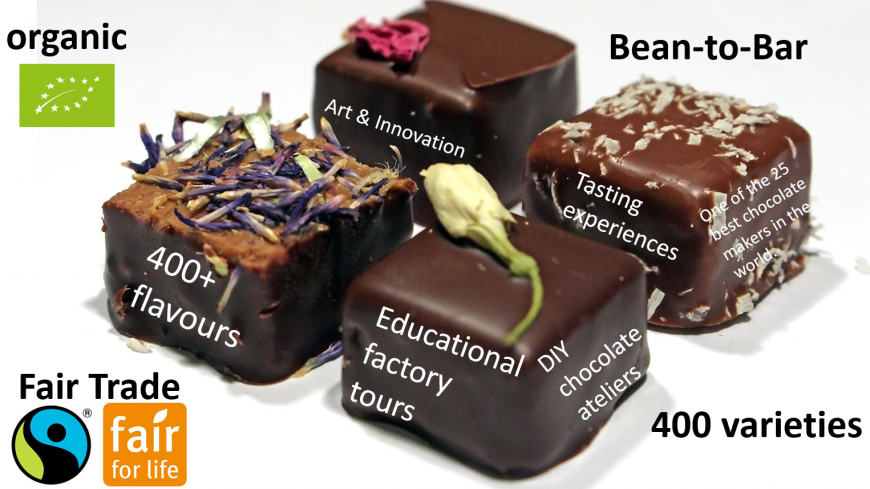
Going Global: the US or China?
“Everything that can be predicted is already part of the known. Our comfort zone is never exciting.” ─ Josef Zotter
Josef’s ambition was to keep innovating and expanding the chocolate business. The obvious place to start with the company’s international expansion was Germany.
But Josef also had other international markets in mind.
Recognizing the intense competition in the European market, that option was quickly abandoned.
This left two main options: the US (also competitive, but a large market) and China, a nascent market with hardly any chocolate consumption. Josef decided to develop the market in China and went for a light-touch e-commerce approach to the US market. In the end, a decisive factor in deciding to pursue the Chinese market was the technical and cultural expertise of Josef’s eldest daughter, Julia.
On the technical side, Julia had a Grand Diploma in patisserie and cuisine from the renowned culinary arts institute, Le Cordon Bleu Paris, where she graduated top of her class in 2013. She had also studied Food Science and Biotechnology at the University of Natural Resources and Life Science in Vienna. She travelled to Brazil to conduct a cocoa research project for her final paper.
On the cultural side, she was a fluent speaker of multiple languages including German, English, French, Portuguese, Spanish, and – most importantly – Chinese. She explained, “We knew we wouldn’t sell a lot of chocolate at first, but we understood that Shanghai was a place for entertainment and experiencing new things.”
Zotter Chocolate finally decided to focus on China, in its first major step outside of Western Europe, with Julia spearheading the effort.
Zotter China
In 2011, in order to enter the Chinese market, Josef began looking for potential business partners. He met an Austrian businessman with a company in Beijing that sold organic products online in China. However, since Shanghai was perceived to have a more international outlook, he introduced Josef to Shanghai-based Amy Fang and Rudi Messner, who had gained a good reputation among companies in the organic food business.
Fang (from Shanghai) and Messner (from Austria) ran their own company in Shanghai, Cedar Essentials Co. Ltd., which imported natural and organic products such as cosmetics and detergents. “After three years, we were probably the number one company for organic detergents in China,” Fang said, “We wanted to devote the rest of our lives to supporting organic trade, which is good for society and the environment.”
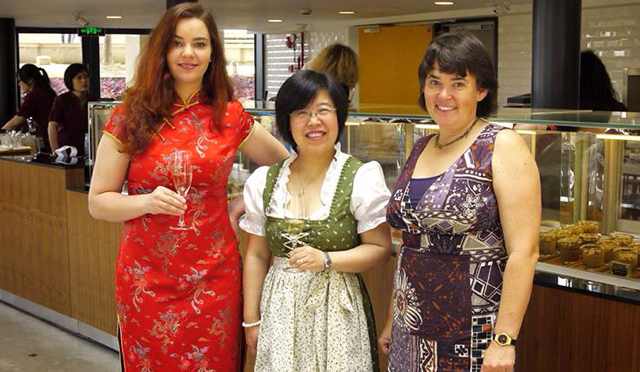
From left: Julia Zotter, Amy Fang and Julia's mom Ulrike.
However, when she was approached about partnering with Zotter Chocolate, Fang immediately detected several differences between the detergent business and the chocolate business, particularly in relation to marketing and distribution. But she was impressed by Zotter’s genuine commitment to organic products. After doing more homework on the chocolate industry – including visits to chocolate shops in Japan, the UK, and the US – Fang and Messner decided to help Zotter enter the Chinese market.
“We must have a good understanding of our Chinese customers,” said Julia, “Chocolates to them are like green tea to us – that is, not very familiar.” So from the beginning, they decided to build a Chocolate Theatre in Shanghai, to raise awareness among Chinese customers.
In December 2012, Zotter Organic Chocolate Shanghai Ltd. was formally registered, with joint investment from Zotter and Cedar Essential (Fang and Messner’s company).
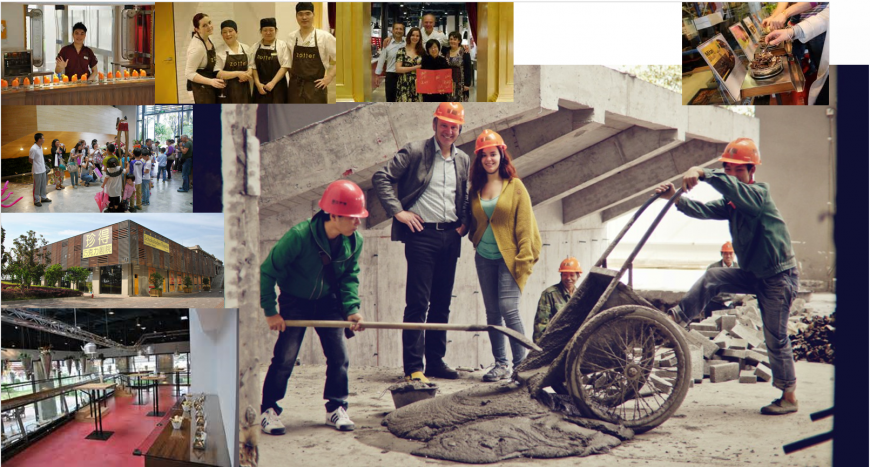
While the Theatre was being constructed, Julia and Josef would frequently visit China. Meanwhile, Zotter China opened its Weibo account, and communicated interactively with its followers, sharing information about the company, and articles on organic food and fair trade.
Exploring the Market
At the end of March 2014, Zotter’s brand-new Chocolate Theatre opened on the banks of the Huangpu River in Shanghai, built in the former cotton warehouse of a 100-year-old clothing factory. Zotter combined its unique style with the beauty of an old brick-stone building. The theatre was 2,400 square metres in size and celebrated the art of Austrian chocolate making. It provided visitors with an opportunity to understand the chocolate manufacturing process, try freshly roasted cocoa beans, taste more than 200 types of chocolate and take a rest in its Viennese-style coffee bar.
Julia observed: “We came to a market like this as a non-chocolate business in a way. We came to raise awareness and show people what chocolate is, with an experience-based concept. The theatre can help them to experience and understand chocolate.”
Innovations in China
Zotter made multiple innovations for the China market. One of the most important ones was the DIY (do it yourself) Chocolate Workshop. It was especially popular with children, who could use various colourful and liquid chocolate to make their own chocolate bar.

Other services introduced to China that did not exist in Austria included a Customized Chocolate Service, Birthday Party Package, and bespoke events for various groups. The company also introduced China-specific packaging for special occasions. For example, Zotter’s designers came up with eight new designs for the Chinese Year of the Rooster. Four of them were selected, based on votes from employees.
Another China-specific innovation was chocolate mooncakes which included four flavours: traditional chocolate and three hand-scooped varieties (pumpkin, strawberry and nuts).
External Challenges
The three-year period from 2012 to 2014 saw double-digit growth in China’s chocolate market, and experts optimistic about growth were predicting that it would become a RMB40 billion market by 2020. E-commerce had greatly promoted its development, accounting for about 20% of total chocolate market revenue in mainland China. The competition among chocolate producers had become quite intense.
However, from 2015, many international chocolate producers experienced a decline in sales revenue as the Chinese economy witnessed a slowdown. By 2016, total retail sales of chocolate in the Chinese market had declined by 4%.
In addition to these changes in the market, Zotter also had other challenges to overcome –cultural differences. Chinese customers were different from Western ones in many ways. For instance, to most Chinese customers, chocolate meant high calories and glucose. Worried about their health and weight, more and more Chinese customers preferred to eat organic and natural food (e.g., nuts), and avoid being extravagant with chocolate. There was also the question of whether Chinese customers would understand the avant garde Zotter Chocolate’s culture.
How could Zotter persuade Chinese customers to ingest their organic chocolates as well as their corporate culture?
People were always the key. Whenever Julia talked about the top managers in Zotter China, she always said how proud she was to have Fang and Messner on board. She gave Messner the position of General Manager in November 2015, while Fang became the Deputy General Manager and Julia herself handled the technical side and product development. By 2016 the shares owned by these two partners had increased to 10% and by 2017 Julia was thinking about asking her father to increase their share ownership even more.
“Rudi is responsible for the marketing strategy, and my main role is execution,” Fang said, “I’m very clear that I’m not a creative person like Josef and Rudi, but if you show me how to do something, I can do it very well. This makes us very good partners with different strengths.”
Life lessons from the Zotter case

This case is a great example of what it’s like for a European company to master the China market. What are the lessons that you came away with, while doing research, which could be helpful for other Austrian – and European firms in general – looking to break into the China market?
CEIBS Associate Professor of International Business and Strategy Shameen Prashantham (S.P): First, I think that it’s important to be clear about what the value proposition for the contemporary Chinese market is. Without a compelling reason to buy, why would customers in another market bother to select your product? Thinking about this may have to include a hard-nosed assessment of what may need to be adapted. The Chinese consumer has been evolving rapidly and it would be foolish to make assessments based on out-of-date perceptions of China. Second, it must be recognized that even though one talks about entering the “China market”, in reality the first step involves a small part of that market. Figuring out the right beachhead is important. For Zotter, Shanghai seemed the obvious choice. For others, it might be sensible to start off in a tier-two or tier-three city, where operations (and mistakes) may be less costly. Third, identifying a reliable partner is important. Often, co-ethnic ties are the first port of call; Josef Zotter’s instinct to reach out to a fellow-Swiss person based in China is a natural one. But while such ties are a great start, it may be important to build on those to forge other relationships with relative strangers. In so doing it’s important to find a partner who can help with deciphering market needs, interfacing effectively with regulatory bodies and executing on the China strategy.

Zotter's Shanghai chocolate theatre.
What are the lessons for Chinese looking to partner with foreign firms that are looking to enter, or have already entered, the domestic market? Are there different approaches for both scenarios, i.e. do you behave differently before the foreign firm has entered and after it is already established a presence in China?
S.P: Pre- and post-entry are sub-processes in a broader process of internationalization. The difference is that before you enter you’re making hypothetical decisions, and once you’ve entered you’re making decisions based on reality. So in making plans it is important to undertake competent external and internal analyses, to assess the power and interest of stakeholders and to come up with an appropriate market entry strategy. But then after entering the market, it may be important to improvise and deal calmly with unexpected setbacks. As Dwight Eisenhower once said, “No battle was ever won without a plan, but no battle was ever won according to plan”. To me developing resilience is one of the key success factors for an international company seeking to operate in China.
When crafting their expansion plans, Zotter narrowed down their locations to either the US or China. In speaking with the family, what would you say are the factors that are most important when making such a choice? Are there any lessons for this for Chinese firms trying to decide on locations for their overseas expansion?
S.P: Actually the Zotters may not be the best textbook example of making strategic plans, since many of their decisions are intuitive! But in any case, comparing entrepreneurial opportunities essentially comes down to three factors: economic viability, feasibility to execute and personal goals. In this case, my own view is that both the US and China offered attractive opportunities in terms of viability and feasibility; personal passion might have tipped the balance in favour of China. It’s important to recognize the importance of personal interests, especially in smaller family businesses – but also to have the maturity to assess if these personal interests can be aligned with the success of the business.
The case talks about the value of having an excellent Chinese partner, in this case Amy Fang. Why was her role so important? What are some of the traits European firms should look for when selecting Chinese partners?
S.P: Entering any international market requires access to new knowledge and networks. For a smaller foreign company, developing the requisite capabilities is often an expensive and difficult process, and so a competent and trustworthy partner can be valuable. And that’s what Fang was to the Zotters. Her deep understanding of local conditions and access to vital networks made it feasible to convert the Zotters’ dream of creating a chocolate theatre in Shanghai into a reality.
Fang had no experience in the chocolate business, yet she was enthused by the prospect of partnering with Zotter. How can Chinese nationals who want to contribute to the success of foreign firms operating in China, prepare themselves for such a role?
S.P: Fang was passionate about something – organic products – and saw a great opportunity to work with Zotter as part of this broader mission. Thus, chocolate wasn’t the key interest per se; it was the chocolate’s organic characteristic. Given that chocolate consumption in China is relatively low, it would have been harder for Zotter to find a chocolate specialist as a partner, and so working with an organic product specialist was probably a sensible option. In the partnership, sensibly relied on the Zotters for the expertise on chocolate, while herself providing the China expertise.
Based on Fang’s success in this case, please share a few tips on best practices that will help Chinese business executives better understand, and collaborate with, Europeans when doing business with, or working in, their companies.
S.P: First, effective partners have common values and complementary strengths. If the shared values aren’t there, the partnership may crumble under pressure. By the same token the strengths need to be there too, since in the first instance the foreign company will likely not have sufficient understanding of local customers, regulations and operational challenges. Second, partners should know their limitations. For instance, their strengths may be limited to certain types of products or regional locations. It’s important to play to one’s strengths and not overstretch. Third, partners must recognize the importance of constant learning – from each other, about the partnering process, and by constantly reviewing current strategy, and making strategic changes with flexibility and agility. This is particularly important in the fast-changing Chinese market.







